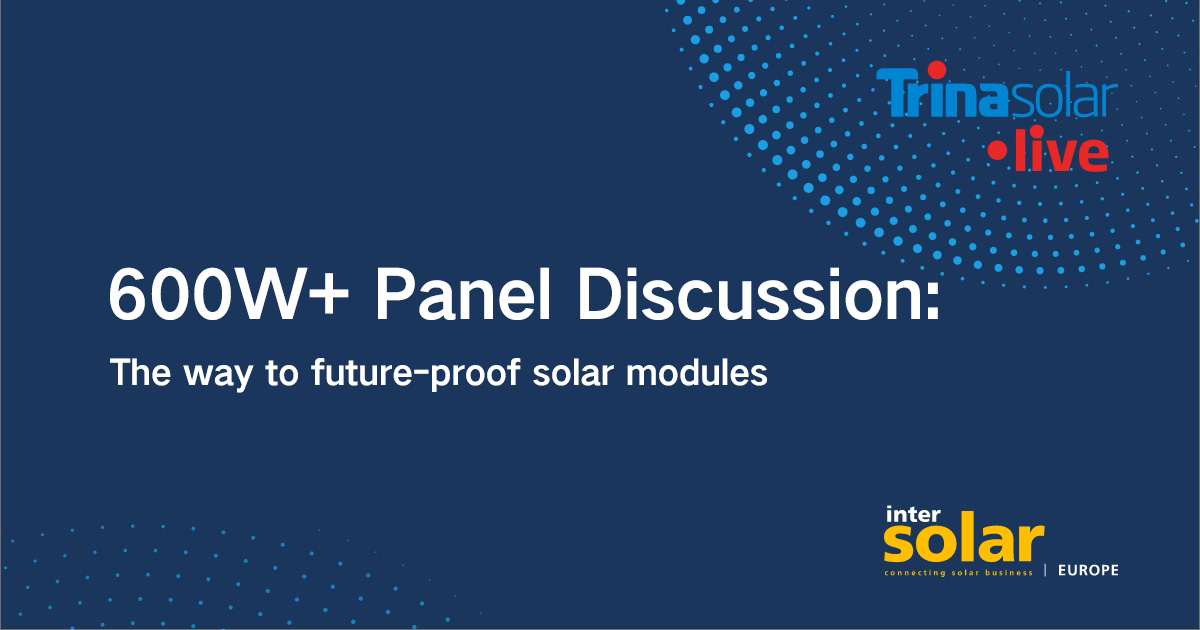On Oct. 8th, the webinar of 600W+ Panel Discussion with Industry Leaders was held by Trina Solar a leading global PV and smart energy total solution provider, during Intersolar, the most influential PV show in Europe.

The webinar, hosted by Michael Schmela, Executive Advisor and Head of Market Intelligence at Solar power Europe, made an in-depth discussion on 210 technology platform, Standardization of 210 technology, LCOE and reliability advantages of the 600W+modules. Canadian Solar, Risen Energy were also in the discussion.
210 has become a technology platform
The industry quickly adapted to 210 technology in the past 1.5 years, including modules, inverter, mounting structures and so on. Gao Lei, product expert at Trina Solar pointed out, the main reason for the fast adoption of 210 technology is collaboration with partners along the value chain for innovation, including ingot, wafer, cell, module, inverter, tracker, EPCs, asset owners. Last month, Trina Solar published white paper on global Inverters matching for Trina Solar Vertex series modules, till now covering 21 mainstream inverter brands and more than 210 inverter models globally.
210 is not merely an innovative product technologically, but also provides greater value because it establishes a highly innovative product technology platform. With this platform, through the synergy of upstream and downstream innovation and R&D, the problems of product reliability, raw material supply guarantee and systematic compatibility have all been solved.
Standardization of 210 technology significantly boosts the chain efficiency and system value
In the panel discussion, Marius Kaiser, Director Technical Department & Product Management, EMEA at Canadian Solar shared his analysis, Standardization is another reason accounting for 210 technology’s rapid spread.
Yifeng Song, Head of Product Management at Risen Energy also addressed his view, with the standardization, customer no need to adopt many sizes, they can purchase products from any suppliers of 210 size.
In November last year eight world-leading photovoltaic brands, including Trina Solar, Zhonghuan Semiconductor and Risen Energy, set about promoting the standardization of 210mm silicon wafer modules in the photovoltaic industry. By May, the 210-standardization process had achieved significant results that the uniform size of 210mm wafer, cell and module has been achieved by more than 20 module manufacturers, EPC, test organization, which is expected to be formally released in October by China Photovoltaic Industry Association. This is significantly driving up the value of the PV industry chain and system level.
210 module’s LCOE advantage proven by third party
LCOE saving is the ultimate goal for new technologies. The experts in the meeting all analyzed the reasons for lower LCOE coming from210 technology. According to Marius Kaiser, Canadian Solar, 210 modules lead to lower electrical system costs. Due to low-voltage and high string-power design, more modules per DC string generate more power, with fewer cables, labor cost etc., resulting in lower BOS costs.
Yifeng Song, Risen Energy, said mechanical elements, such as lower mounting structure costs and civil work cost, besides the optimized package design for highest capacity per container, also contribute to the lowest LCOE and best LCOE, that’s why 210 gets popular.
Gao Lei, Trina Solar quoted Fraunhofer ISE’s latest study, that the new generation of 210mm (G12) and 182mm (M10) modules perform better than the conventional 166mm (M6) modules in both CAPEX and LCOE, G12 modules are superior to the M10 modules. The LCOE of the Trina Solar Vertex G12 670W is 4.5% lower than that of the M10 585W modules, and is up to 7.4% lower than that of the M6 455W modules. The serial LCOE study by Fraunhofer ISE and DNV all demonstrates outstanding system value of 600W+ modules.
Mechanical reliability fully verified, after passing 6 rigorous tests
210 modules are much more powerful and also larger in size than conventional solar modules. Reliability becomes another hot topic in the panel discussion. Gao Lei shared all the 6 rigorous tests: static mechanical load test, non-uniform snow-load test, extreme low-temperature mechanical Load test, hail test, extreme DML test and extreme wind tunnel test, the serial testing results, all of which are beyond industry standard tests, achieving an across-the-board verification of the excellent mechanical load reliability of the 670W Vertex modules.
210 technology becomes well accepted by the market in such short time. By working with partners along the value chain, 600W+ industry chain together innovates future-proof technologies, making solar energy one of the main energy sources.
